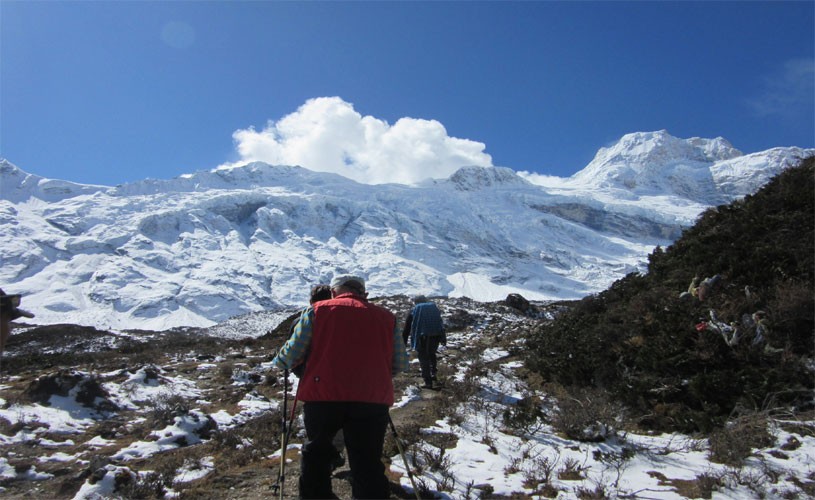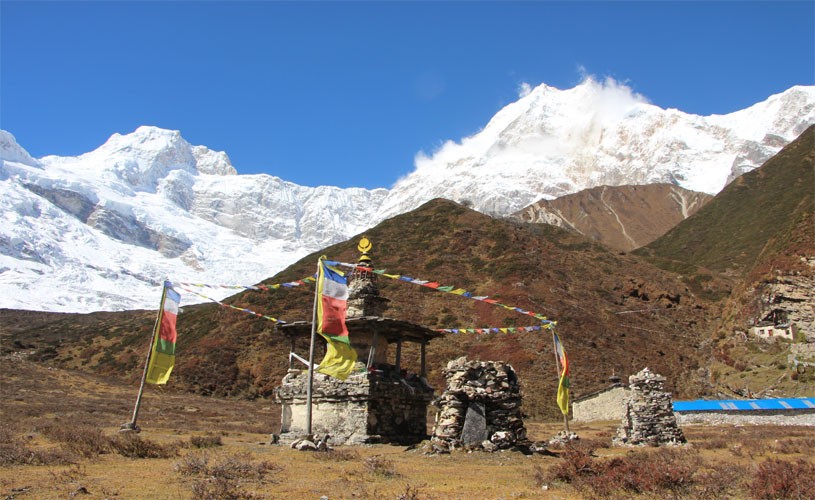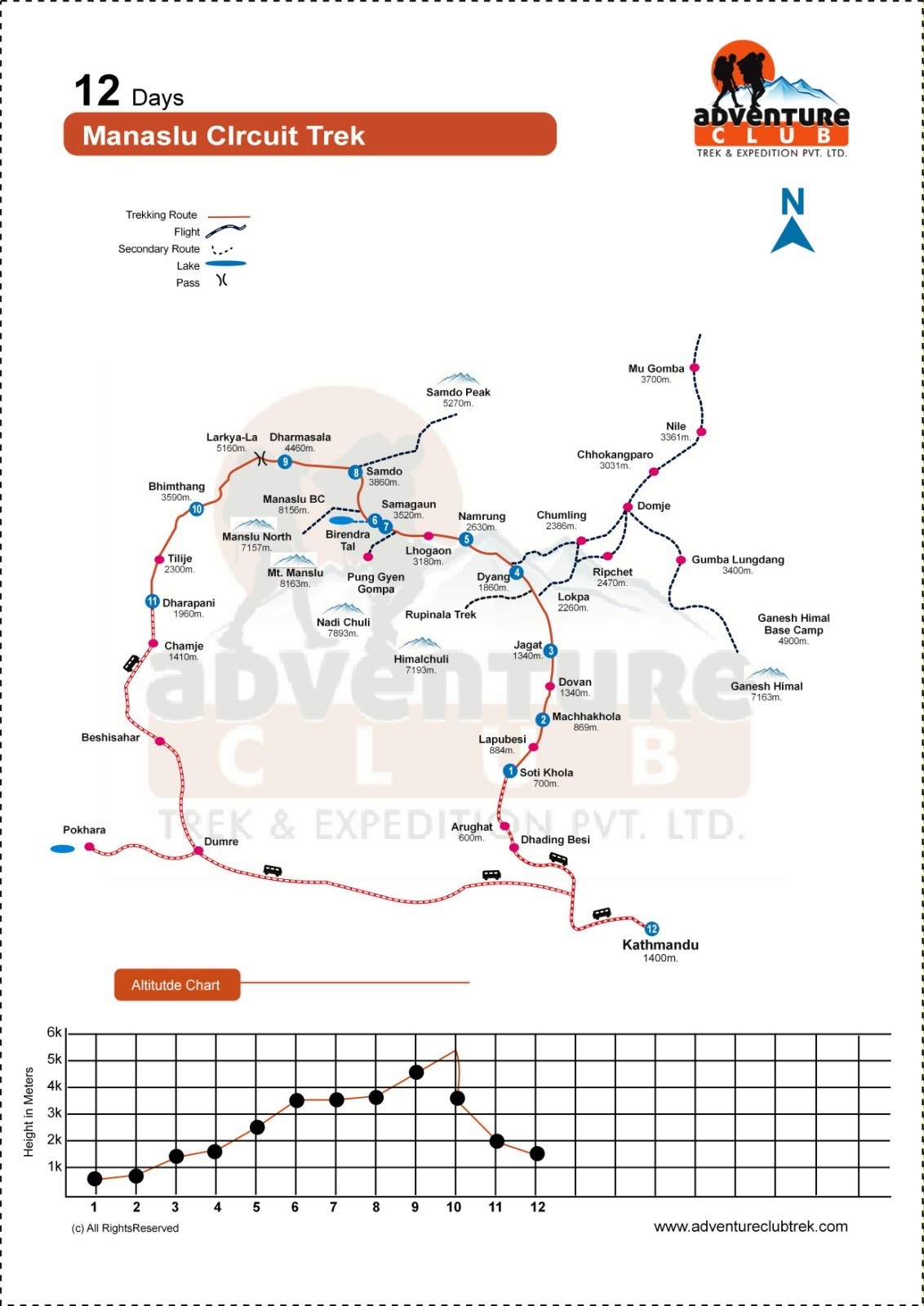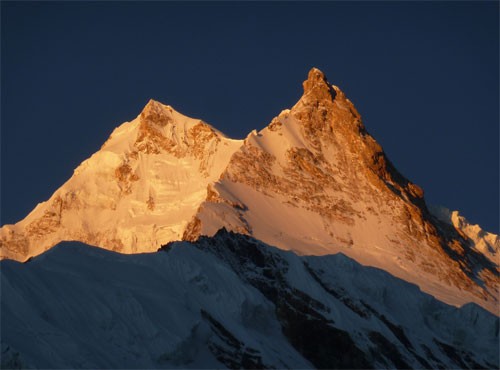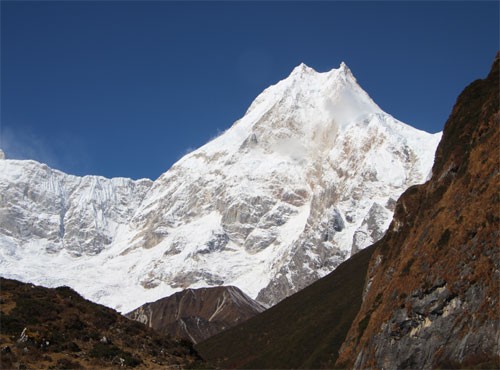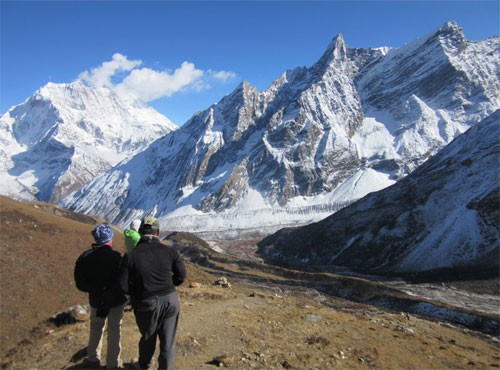Manaslu Circuit Trek: 12-Day Highlights:
- Cross the challenging Larkya La Pass.
- Explore ancient monasteries and rich cultural heritage.
- Admire stunning views of Mount Manaslu, the world’s eighth-highest peak.
- Interact with locals in remote villages.
- Experience the majestic Budhi Gandaki River valley.
- Observe unique flora and fauna along the trekking trails.
- Relax in natural hot springs after a day of hiking.
- Marvel at the breathtaking Pungyen Glacier.
- Enjoy panoramic views from Cheo Himal.
Manaslu Circuit Trek: A Thrilling Himalayan Adventure
The Manaslu Circuit Trek offers an extraordinary journey through the breathtaking and adventurous Himalayan landscapes of Nepal. This remarkable trek, organized by Adventure Club Trek, allows you to immerse yourself in the untouched natural beauty of Nepal’s hidden trails.
As you trek through picturesque Buddhist landmarks and remote village settlements, you’ll be captivated by the rich cultural heritage and serene surroundings. Towering mountain peaks, glacial lakes, stunning glaciers, and high-altitude passes make this trek an unparalleled adventure.
The Manaslu Circuit Trek is a spectacular off-the-beaten-path experience in the Manaslu region, located approximately 50 miles from Kathmandu, in Nepal’s Gorkha district. At the heart of this region stands Mount Manaslu (8,163m)—the world’s eighth-highest peak, part of the Mansiri Himalayan sub-range.
Along the trail, you will pass through traditional Gurung villages, as well as settlements of the Bhutia, Sherpa, and Tibetan communities. The region is deeply influenced by Buddhism, evident in its numerous monasteries, mani walls, chortens, and prayer flags that line the trekking route.
Your journey begins in Machha Khola, trekking through rugged landscapes toward Jagat (1,340m). From there, the trail takes you through stunning scenery, leading to Deng (1,860m)—a charming village offering incredible views of snow-capped peaks and unique landscapes.
Continuing onward, you’ll reach Namrung (2,630m), a culturally rich settlement with significant Buddhist influences. After exploring the area, the trek leads you to Lho (3,180m), followed by Samagaun (3,500m), where you’ll acclimatize while soaking in panoramic mountain vistas.
The journey then proceeds to Samdo (3,875m) and Dharamsala (4,480m), setting the stage for one of the most thrilling parts of the trek.
A major highlight of the trek is Larkya La Pass (5,213m)—the highest point of the journey. From this vantage point, trekkers are rewarded with breathtaking views of Himlung Himal, Annapurna II (7,937m), Kang Garu, Cheo Himal, and Gyaji Kung.
The descent takes you to Bimtang (3,720m), followed by a trek to Tilije (2,300m). The adventure then leads to Dharapani, where you can unwind before driving to Besisahar (760m)—a bustling town that serves as a gateway to various destinations in Nepal.
The Manaslu Circuit Trek is widely regarded as one of Nepal’s most beautiful and rewarding trekking experiences. While it was only opened for trekking in 1991, it has quickly gained popularity for its breathtaking scenery and authentic Himalayan adventure. The Larkya La Pass (5,106m) is the highest point of the trek, offering unparalleled views of the surrounding peaks.
The final leg of the journey takes you on a scenic drive back to Kathmandu, where you can relax and reflect on your incredible adventure. Verdant hills, cascading waterfalls, and pristine rivers provide a stunning backdrop as you make your way back to civilization.
Upon returning to Kathmandu, you’ll have the opportunity to explore the city, celebrate your successful trek, and prepare for your onward journey. At Adventure Club Trek, we provide this spectacular trekking experience at a reasonable cost, ensuring an unforgettable journey through the Himalayas. Explore more about the Manaslu Circuit Trek and start planning your next adventure with us!
Other similar treks in the Manaslu Region. Offering various options for duration and experiences. These treks combine the breathtaking views of Manaslu with the convenience of acclimatization, offering an unforgettable adventure for trekking enthusiasts looking to save time while enjoying spectacular aerial views of the Himalayas. Some popular choices include
The 12-Day Manaslu Circuit Trek itinerary includes private transportation, such as Jeeps or vans, from Kathmandu to Kathmandu to ensure a comfortable and timely journey. However, if you're looking for a budget-friendly option, we can Customize the itinerary to include public transportation, such as local buses or public Jeeps, which will help reduce the cost slightly. Please feel free to contact us, and we will be happy to tailor the itinerary to suit your preferences and needs.
When is the best time to do Manaslu circuit trekking?
Pre-monsoon season, from March to May, and post-monsoon season, or from late September to December, are the optimum times to complete this Manaslu trek. The best months are often considered any time in October, November, April, and May. September, December, and March are additional suggested months for this walk. In our opinion, the next months are not ideal for undertaking this walk. It is extremely dangerous to cross the Larkya La Pass in January and February because of the high snowfall. It is best to avoid June, July, and August because of the risk of flooding and landslides brought on by excessive rains.
How difficult is the 12-day Manaslu Circuit Trek?
Manaslu Circuit Trek covers approximately 177km/110 mi. On a 14-day itinerary, you'll walk for 10-11 days. This means that, on average, you'll cover 15-20km (9-12mi) daily. Each day. It is difficult to walk the first few days of the trail due to the steep Budi Gandaki Gorge and the uphill and downward walks. The Larkya La Pass is 5,106m /16752ft) high. This trek is the most difficult, with long hikes on snow-covered trails. Altitude sickness is a major challenge you may face on this trek due to the wide variations in altitude. If you are not doing it in the winter, you do not need mountaineering or hanging skills. You must be physically fit and in good shape, even if it is your first time. Strength and endurance training and cardio fitness training are recommended to maintain fitness levels at least three months before starting the trek.
Trekking Permits for Manaslu Circuit Trek
The government of Nepal has decided to limit tourism in the Manaslu Region, which is the area between Jagat and Dharapani. This means that people who want to trek there alone can't do so. Instead, they need to get a special permit. Also, if you want to trek in this region, you have to be in a group of at least two people with a local guide. You can't just go with any guide; it has to be someone from a registered agency. You'll need three different permits for the Manaslu trek and an extra one if you plan to visit Tsum Valley as well.
Special Restricted Area Permit for Manaslu (Manaslu RAP
The Cost of the Trekking permits
From September to November: USD 100 per person in the first seven nights and USD 15 extra per person each day after the eighth night.
From December to August: USD 75 per person for the initial seven days, and USD 10 extra per person each day after the eighth.
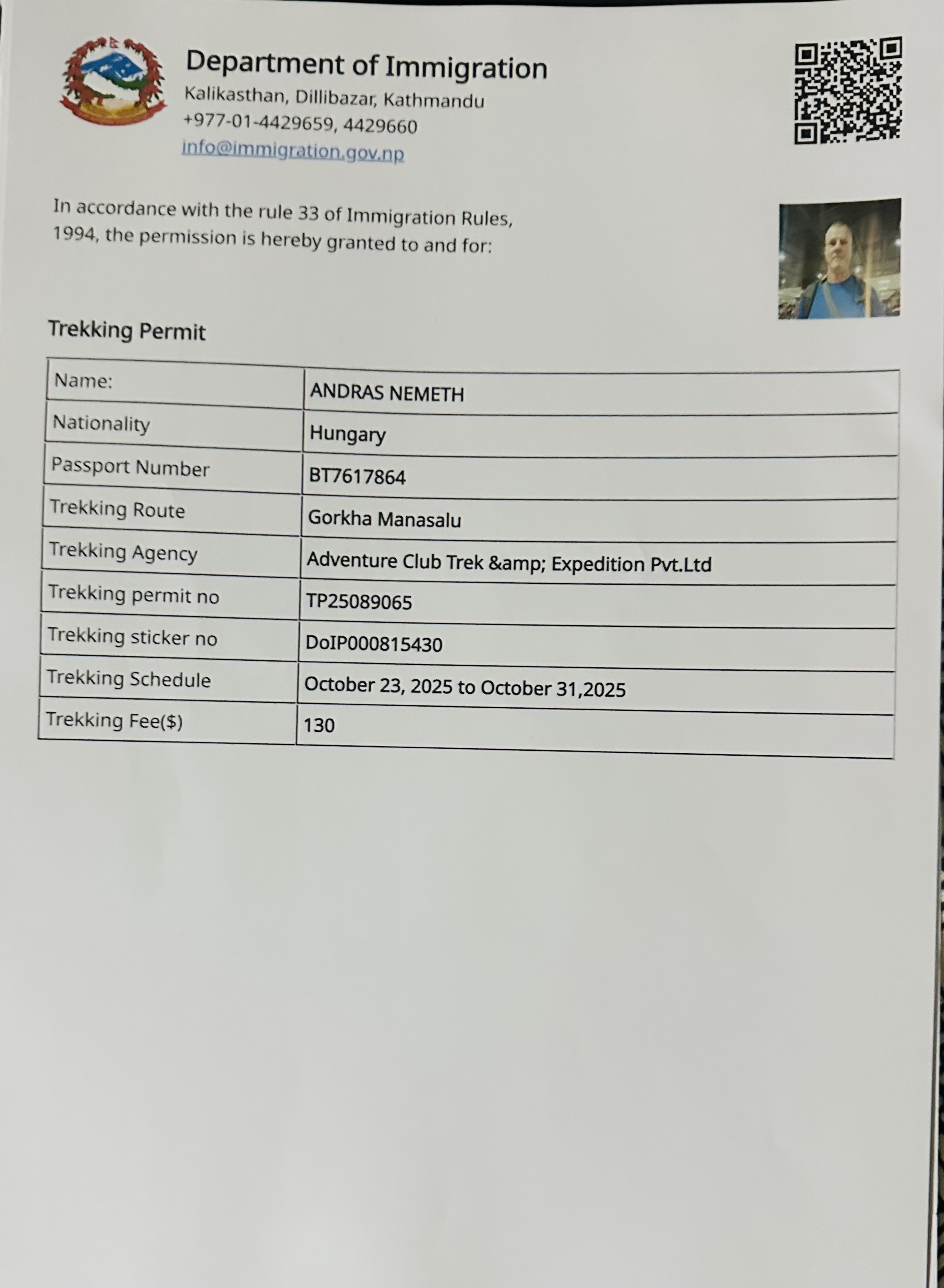
Annapurna Conservation Area Project (ACAP Permit)
You will need this permit from Dharapani to exit ACAP at Beshi Sahar. The cost of any day spent in the ACAP conservation zone is USD30.
Manaslu Conservation Area Project (MCAP Permit)
This permit is required from Philm, where the Manaslu Conservation Area starts. The price is USD30 year-round for any days you spend inside the conservation area.

Accommodation on the Manaslu Circuit Trek
Accommodation on the Manaslu Trek includes clean huts and teahouses. Some places have upgraded guesthouses. The guesthouses have room heaters, en suite toilets and bathrooms, and a heated floor. The lodge owners add new facilities every year to improve the comfort of their guests. We will book the best lodges and guesthouses along the route for the duration of your trek when you book with Adventure Club Trek.
Food on the Manaslu Circuit Trek
Manaslu Trekking will serve all meals on a full-board basis, whereas in Kathmandu, only breakfast is served. Three meals are served daily during trekking from menus of tea houses, lodges, or local homes. We eat breakfast and dinner every day in the same location where we spend the night. Lunch will be served in a teahouse on the way to our destination. The Manaslu area has a different level of tourist infrastructure than exists in the Annapurna and Everest regions (and this is what makes this region so attractive). There will be no variety of food available. Tibetan bread, dal bhat, and tsampa are the main local foods. Adventure Club Trek recommends that we are prepared for a small adventure.
Is there Wi-Fi and a telephone in the Manaslu Circuit Trek?
All of the teahouses where you will spend the night have electricity. Paying a little fee, you can use communal hydroelectricity or solar panels to recharge your phones, laptops, and other electronic devices. We strongly advise bringing backup rechargeable power banks or extra batteries. We do not recommend bringing your laptop because there is no free WiFi along the trekking trail, and the telephone service may be better. Although some teahouses charge for hourly WiFi access, don't anticipate high-speed internet on the inaccessible trails.
Mode of Transportation to Manaslu Circuit Trek
We will begin our journey by traveling 160 kilometers (99 miles) from Kathmandu to Maccha Khola via Soti Khola. By private jeep, it takes 7 hours, and by local jeep, it takes 8 -9 hours. The entire first day of the trip consists of an off-road adventure ride. After the hike, you will take a Jeep for a six-hour drive from Dharapani before switching to another Jeep or local bus for a seven-hour travel to Kathmandu.
Drinking Water on Manaslu Circuit Trek
Water available in taps, streams, or river water is detrimental and unfit for drinking. Sadly, large fractions of the Nepalese population in rural and urban areas are deprived of safe and adequate drinking water. We recommend that our travelers drink boiled or purified water by adding purification agents. Although we discourage bottled mineral water, if you have to use it, double-check that the seal is intact and that the top of the bottle has yet to be manhandled. Overall, it is very important to drink adequate water while trekking in Nepal to avoid any threats associated with dehydration and altitude sickness. A liter of mineral water at lower-elevation tea houses costs around USD 1 but at higher elevations costs up to $4, so the cost can add up.
Trekking Permits for Manaslu Circuit Trek
The government of Nepal has decided to limit tourism in the Manaslu Region, which is the area between Jagat and Dharapani. This means that people who want to trek there alone can't do so. Instead, they need to get a special permit. Also, if you want to trek in this region, you have to be in a group of at least two people with a local guide. You can't just go with any guide; it has to be someone from a registered agency. You'll need three different permits for the Manaslu trek and an extra one if you plan to visit Tsum Valley as well.
Special Restricted Area Permit for Manaslu (Manaslu RAP
The Cost of the Trekking permits
From September to November: USD 100 per person in the first seven nights and USD 15 extra per person each day after the eighth night.
From December to August: USD 75 per person for the initial seven days, and USD 10 extra per person each day after the eighth.
Manaslu Conservation Area Project (MCAP Permit)
This permit is required from Philm, where the Manaslu Conservation Area starts. The price is USD30 year-round for any days you spend inside the conservation area.
Annapurna Conservation Area Project (ACAP Permit)
You will need this permit from Dharapani to exit ACAP at Beshi Sahar. The cost of any day spent in the ACAP conservation zone is USD30.

